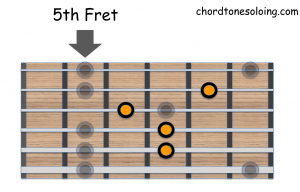The Hefni Pentatonic System
What is the Hefni Pentatonic System?
The Hefni Pentatonic System is a system of altered pentatonic scales that allows guitarists to play chord tones in scalar form. This essentially bridges the disconnect between scales and chord tones, thus making chord tone soloing accessible to all guitarists.
An altered pentatonic scale is simply a major or minor pentatonic scale with one or more notes altered. They are still 5 note scales but they have different tonalities from the usual major or minor pentatonic. Altered Pentatonics is not a widely studied field on guitar. While there have been a few books published on the topic, they all seem to have only touched the surface of the topic.
The Hefni Pentatonic System is a system of 55 pentatonic scales which are all diatonic to the major scale. These are then grouped into 11 scale families with common tonalities. These pentatonic scales were reconfigured into 2-notes-per-string fingerings so that they can be easily alternate picked.
8 Years of Research
In 2013, I embarked on research into altered pentatonic scales. I was primarily interested in the different lines that can result by simply changing a note or two in the pentatonic scales. I noticed that by changing a single note, sometimes radically altered the tonality of the scale. The main focus of my research was how to use these scales diatonically therefore I chose pentatonic scales which fit primarily the major scale and omitted those that didn’t.
As the years progressed, I discovered that the ‘altered’ pentatonic scales can be grouped according to tonal families sharing the same sound quality. These were
1. Major 7th
2. Minor 7th
3. Dominant 7th
4. Half Diminished
Sometimes these scale families exhibited multiple tonalities.
When Less is More
I recall reading in a guitar magazine in the 90’s pertaining to how Jimi Hendrix effectively hit the chord tones of Emin7 by simply playing the E minor pentatonic scale in Little Wing. While this fact didn’t register significantly until much later, it dawned on me that sometimes the scales we are playing already contained the chord tones but mixed in with many other non chord tones. If we could find a way to eliminate the latter then, chord tone soloing will have been more effective.
If we were to analyse the Emin7 chord, they contain the notes E, G, B and D.
The notes for E minor pentatonic are E, G, A, B and D. Essentially they spell the chord tones for Emin7 but with the addition of an A note.
While the actual chord in Little Wing is the Emin triad, Emin7 is a common harmonic substitution to make the chord more complex sounding.
Chord Tone Soloing with the Hefni Pentatonic System
If we mapped the chord changes of a standard blues chord progression on the fretboard, we get the visual structures as shown below
D7 Chord (5th Position)

G7 Chord (4th Position)

A7 Chord (6th position)

The diagrams below are 3 examples of altered pentatonics that hit all of the chord tones in D Blues. You can clearly see how the chord structures fit within the scale diagrams.
The Robben Ford Pentatonic Scale

Dominant 9th Pentatonic Mode 2

Eric Johnson Pentatonic Scale

Pentatonic Change Sequence
Guitar players tend to stick to a singular scale when soloing. However, as the above diagrams show, the scale changes in the passage of play. I call this a ‘Pentatonic Change Sequence’ and this is the basis of the Hefni Pentatonic System. In other words, the system is built around combinations of altered pentatonic scales that change accordingly with the chord changes. There are as many altered pentatonic scales that fit a single chord and the various combinations result in the different pentatonic change sequences that you will encounter.
How do We Begin Learning The Hefni Pentatonic System
From my years of teaching, I realise that not every guitar student has the benefit of having learnt music theory so presenting the system through notation will not work for such students. As an educator, I have also learnt that there are different types of learners and there is no one singular method that works for all. For guitar players who have adequate harmony and wish to go into the intricacies of the system, I will provide the relevant theory to explain the method.
For the absolute beginner, I would advise to simply learn the scale diagrams according to the pentatonic change sequence and you will be able to use them even if you don’t understand why. When you get better with harmony down the road, you may revisit the theory behind why it works.
I have arranged the Hefni Pentatonic System into several phases. The first phase introduces the altered pentatonics scales in the system and is a good place to start for most learners. The 2nd to 4th phases introduces instruction on how to apply these scales for chord tone soloing in increasing complexity.
Chapters:
Below are the chapters which will be unlocked as the weeks progress.
- Foundation
a) Rethinking the Pentatonic Scale
b) 3 to 1 Rule for Guitar - Major 9th Pentatonic Family
- Locrian Pentatonic Family
- Aeolian Pentatonic Family
- Dominant 9th Pentatonic Family
- Javanese Pentatonic Family
- Half Diminished Pentatonic Family
- Mixolydian Pentatonic Family
- Minor 9th-Pentatonic Family
- Hefni Dominant Pentatonic Family
